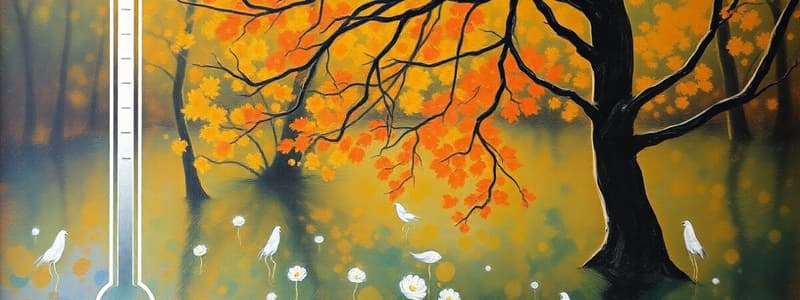Podcast
Questions and Answers
What is the first step in converting a temperature from Fahrenheit to Celsius using the formula?
What is the first step in converting a temperature from Fahrenheit to Celsius using the formula?
- Subtract 32 from the Fahrenheit temperature (correct)
- Divide the Fahrenheit temperature by 9
- Multiply the Fahrenheit temperature by 5
- Add 273.15 to the Fahrenheit temperature
To convert a Celsius temperature to Kelvin, which operation must be performed?
To convert a Celsius temperature to Kelvin, which operation must be performed?
- Subtract 273.15
- Add 100
- Add 273.15 (correct)
- Multiply by 1.8
When converting from Kelvin to Fahrenheit, which of the following is the correct initial step?
When converting from Kelvin to Fahrenheit, which of the following is the correct initial step?
- Divide the Kelvin temperature by 5
- Subtract 273.15 from the Kelvin temperature (correct)
- Add 273.15 to the Kelvin temperature
- Subtract 32 from the Kelvin temperature
Which practical application of temperature conversion is mentioned related to cooking?
Which practical application of temperature conversion is mentioned related to cooking?
In the formula for converting Fahrenheit to Celsius, after subtracting 32, what is the next step?
In the formula for converting Fahrenheit to Celsius, after subtracting 32, what is the next step?
What is an essential reason for performing temperature conversions in scientific research?
What is an essential reason for performing temperature conversions in scientific research?
Which formula represents the conversion from Kelvin to Fahrenheit correctly?
Which formula represents the conversion from Kelvin to Fahrenheit correctly?
Flashcards are hidden until you start studying
Study Notes
Fahrenheit To Celsius Conversion
- Formula: ( C = \frac{(F - 32) \times 5}{9} )
- Breakdown:
- Subtract 32 from the Fahrenheit temperature.
- Multiply the result by 5.
- Divide by 9 to get Celsius.
Celsius To Kelvin Conversion
- Formula: ( K = C + 273.15 )
- Breakdown:
- Add 273.15 to the Celsius temperature to convert to Kelvin.
Kelvin To Fahrenheit Conversion
- Formula: ( F = \frac{(K - 273.15) \times 9}{5} + 32 )
- Breakdown:
- Subtract 273.15 from the Kelvin temperature.
- Multiply the result by 9.
- Divide by 5 and then add 32 to find Fahrenheit.
Practical Applications Of Temperature Conversions
- Weather Reporting: Conversions are essential for understanding temperature in various units in different regions.
- Scientific Research: Consistent temperature measurements in experiments where different scales are used.
- Culinary Arts: Cooking temperatures may be given in Fahrenheit or Celsius; conversions ensure accurate cooking.
- Industrial Processes: Different industries may require specific temperature scales for equipment operation or safety standards.
- Climate Studies: Understanding global temperature data often requires conversions between scales for accurate comparisons and analyses.
Fahrenheit to Celsius Conversion
- Formula: ( C = \frac{(F - 32) \times 5}{9} )
- Subtract 32 from the Fahrenheit temperature.
- Multiply the result by 5.
- Divide by 9 to get Celsius.
Celsius to Kelvin Conversion
- Formula: ( K = C + 273.15 )
- Add 273.15 to the Celsius temperature to convert to Kelvin.
Kelvin to Fahrenheit Conversion
- Formula: ( F = \frac{(K - 273.15) \times 9}{5} + 32 )
- Subtract 273.15 from the Kelvin temperature.
- Multiply the result by 9.
- Divide by 5 and then add 32 to find Fahrenheit.
Practical Applications of Temperature Conversions
- Weather reporting relies on temperature conversions for accurate understanding across regions utilizing different units.
- Scientific research requires consistent temperature measurement across experiments using various scales.
- The culinary arts utilize temperature conversions for accurate cooking, as recipes often list temperatures in either Fahrenheit or Celsius.
- Industrial processes rely on precise temperature conversions for equipment operation and safety standards.
- Climate studies necessitate conversions between temperature scales for accurate global data comparisons and analyses.
Studying That Suits You
Use AI to generate personalized quizzes and flashcards to suit your learning preferences.




